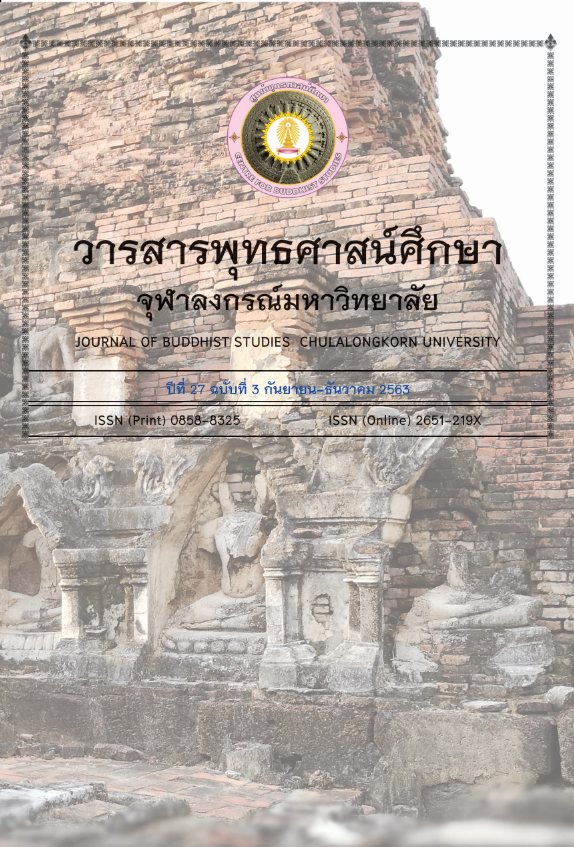ความหลากหลายในการตีความแนวคิดเรื่องจิตของนิกายโยคาจาร
คำสำคัญ:
จิตนิยมทางอภิปรัชญา, การตีความแบบพหุนิยม, พระพุทธศาสนายุคต้น, พระพุทธศาสนานิกายโยคาจาร, พหุนิยมทางศาสนาบทคัดย่อ
งานวิจัยเรื่องนี้มุ่งศึกษาความหลากหลายในการตีความแนวคิดเรื่องจิตของนิกายโยคาจาร โดยเน้นเฉพาะการตีความแบบพหุนิยมที่สัมพันธ์กับพระพุทธศาสนายุคต้น จากนั้น ผู้วิจัยจะนำเสนอการวิเคราะห์รูปแบบการตีความดังกล่าวผ่านแนวคิด “พหุนิยมทางศาสนา” ของจอห์น ฮิค เพื่อตอบคำถามว่า แนวคิดของนิกายโยคาจารที่วิเคราะห์บนฐานพระพุทธศาสนายุคต้นนั้น สามารถเป็นพหุนิยมทางศาสนาตามกรอบแนวคิดของฮิคได้หรือไม่ อย่างไร
จากการศึกษาพบว่า คำสอนของนิกายโยคาจารไม่ได้มีศูนย์กลางอยู่ที่ปัญหาว่าอะไรมีอยู่จริงหรือไม่มีอยู่จริงทางอภิปรัชญา หากแต่มีศูนย์กลางอยู่ที่ปัญหาทางจริยธรรมเกี่ยวกับความทุกข์ในสังสารวัฏของมนุษย์ปุถุชนอันเกิดจากการทำงานทางจิตของพวกเขา โดยนัยนี้ แนวคิดเรื่อง “จิตตมาตร” ของนิกายโยคาจารที่ได้รับการตีความแบบจิตนิยมทางอภิปรัชญาจึงถือว่าไม่สอดคล้องกับจุดยืนโดยรวมของนิกายโยคาจาร
การวิเคราะห์แนวคิดพระพุทธศาสนายุคต้นและนิกายโยคาจารผ่านแนวคิดพหุนิยมทางศาสนาของจอห์น ฮิค ผู้วิจัยพบว่า (1) ด้านความจริงแท้: พระพุทธศาสนามีจุดยืนแตกต่างจากฮิคในแง่ที่ไม่ได้มองความจริงสูงสุดว่ามีศูนย์กลางอยู่ที่พระเจ้า หากแต่มองว่ามีศูนย์กลางอยู่ที่กฎของธรรมชาติ (2) ด้านข้อจำกัดของการรับรู้ความจริง: พระพุทธศาสนาและฮิคมีทัศนะคล้ายกันว่า การรับรู้ทางอายตนะของมนุษย์มีข้อจำกัด คือ เราไม่ได้รับรู้สิ่งทั้งหลายตามที่เป็นจริง หากแต่รับรู้ตามที่มีประสบการณ์ (experiencing-as) และตามที่เห็น (seeing-as) ซึ่งข้อจำกัดในการรับรู้นี้นำไปสู่การอ้างความจริงที่ขัดแย้งกันของศาสนาต่างๆ (the conflicting truth-claims) (3) ด้านการนำเสนอความจริง: ทั้งพระพุทธศาสนาและฮิคมีความคล้ายกันว่า มนุษย์มีข้อจำกัดในการเสนอความจริง กล่าวคือระบบสัญลักษณ์ต่างๆ ที่เรามีอยู่ เช่น ภาษา ไม่สามารถถ่ายทอดความจริงได้อย่างสมบูรณ์แบบ และ (4) การยอมรับวิถีทางของศาสนาอื่น ฮิคมองว่า วิถีทางสู่ความรอดของศาสนาทั้งหลายมีความเท่าเทียมกัน ไม่มีวิถีทางใดเด่นหรือด้อยไปกว่ากัน ทุกศาสนาล้วนมีฐานะเป็นบริวารของศูนย์กลางเดียวกัน (พระเจ้า) เช่นเดียวกับดาวเคราะห์ต่างๆ ที่เป็นบริวารของศูนย์กลางเดียวกัน คือ ดวงอาทิตย์ พระพุทธศาสนาไม่เห็นด้วยกับความเป็นพหุนิยมตามแนวคิดนี้ พระพุทธศาสนายอมรับว่าวิถีทางศาสนาอื่นๆ ก็สามารถไปสู่การบรรลุธรรมบางระดับได้เหมือนกัน รวมมีทั้งมีท่าทีเปิดกว้างเกี่ยวกับเสรีภาพในการนับถือศาสนา โดยให้แต่ละคนพิจารณาตัดสินด้วยสติปัญญาของตนเองว่าควรจะนับถือศาสนาใด
Downloads
References
Burton, David. (2002). Emptiness Appraised : A Critical Study of Nāgārjuna’s Philosophy. London: Curzon Press.
Chatterjee, Ashok Kumar. (1975). The Yogācāra Idealsim. Delhi : Motilal Banarsidass.
Dasgupta, S.N. (1962). Indian Idealsim .Cambridge: The Syndics of the University Press.
Divatia, Shuchita C. (1994). Idealistic Thought in Indian Philosophy. Delhi: D.K. Printworld (P) Ltd.
Harris, Ian Charles. (1991). The Continuity of Madhyamaka and Yogācāra in Indian Mahāyāna Buddhism. Leiden: E.J. Brill.
Hick, John. (2002). John Hick: An Autobiography. Oxford: Oneworld.
Hick, John. (2002). A Christian Theology of Religions: The Rainbow of Faiths. Louisville, KY: Westminster John Knox, 1995.
Hick, John. (1973). God and the Universe of Faiths. New York: St. Martin’s.
Hick, John. (2002). An Interpretation of Religion: Human Responses to the Transcendent. New Haven: Yale University Press. Hick, John. (1985). Problems of Religious Pluralism. New York: St. Martin’s.
Huntington, C.W. Jr. (1989). The Emptiness of Emptiness. Delhi: Motilal Banarsidass.
Kochumuttom, Thomas A. (1982). A Buddhist Doctrine of Experience. Delhi: Motilal Banarsidass.
Lamotte, Etienne. (1935). Samdhinirmocana Sutra : L’Explication des Mysteres. Paris : Adrien Maisommeuve.
Lopez, Donald S. (1987). A Study of Svātantrika. New York: Snow Lion Publications.
Lopez, Donald S. (1988). Buddhist Hermeneutics. Honolulu : University of Hawai Press.
Lustraus, Dan. (2002). Buddhist Phenomenology (London & New York: RoutledgeCurzon.
Mitta, Kewal Krishan. ed. (1993). Vijñānavāda (Yogācāra) and Its Tradition. Delhi: University of Delhi.
Murti, T.R.V. (1974). the Central Philosophy of Buddhism. London: George Allen and Unwin Ltd.
Nagao, Gadjin. (1989). The Foundational Standpoint of Madhyamika Philosophy. Delhi: Sri Satguri Publication.
Nagao, Gadjin. (1992). Madhyamika and Yogacara. Delhi: Sri Satguru Publications.
Naht Hanh, Thich. (2001). Transformation at the Base. California: Parallax Press, 2001.
Powers, John. (1993). Hermeneutic and Tradition in the Samdhinirmocana-Sutra. Leiden: E.J. Brill.
Rahula, W. (2003). Zen and the Taming of the Bull. Colombo: Print & Print Graphics (Pvt) Ltd.
Raju, P.T. (1953). Idealistic Thought of India . London: George Allen & Unwin Ltd.
Schmithausen, Lambert. (1987). Ālayavijñāna. Tokyo: the International Buddhist Institute for Buddhist Studies.
Sharma, C.D. (1964). A Critical Survey of Indian Philosophy. Delhi : Motilal Banarsidass.
Singh, Amar. (1984). The Heart of Buddhist Philosophy Dińnāga and Dhammakīrti. Delhi: Munshiram Manoharlal Publishers Pvt. Ltd.
Stcherbatsky, Th. (1994). Buddhist Logic. 2 Volumes. Delhi: Motilal Banarsidass.
Stcherbatsky, Th. (1970). The Central Conception of Buddhism. Delhi: Indological Book House.
Stcherbatsky, Th. (1971). Madhyānta-vibhańga: Discourse on Discrimination Between Middle and Extreme. Calcutta: Indian Studies, Past and Present.
Suzuki, D.T. (1972). Studies in The Lankāvatāra Suttra. London: Routledge & Kegan Paul Ltd.
Vasubandhu. (1971). Madhyānta-vibhańga : Discourse on Discrimination Between Middle and Extreme. (Th. Stcherbatsky, trans.). Calcutta: Indian Studies, Past and Present.
Vasubandhu. (1986). Seven Works of Vasubandhu. (Stefan Anacker, trans.) Delhi: Motilal Banarsidass.
Williams, Paul. (1989). Mahāyāna Buddhism. London and New York: Routledge.
Willis, Janice Dean. (1972). On Knowing Reality. New York : Columbia University Press.
Wood, Thomas E. (1994). Mind Only : A Philosophical and Doctrinal Analysis of the Vijñānavāda. Delhi: Motilal Banarsidass.
Hall, Bruce Cameron. (1986). The Meaning of Vijñapti in Vasubandhu’s Concept of Mind. The Journal of the International Association of Buddhist Studies, 9(1) (1986),7-24.
Lusthaus, Dan. (1999). A Brief Retrospective of Western Yogacara Scholarship in the 20th Century. Document presented at the 11th International Conference on Chinese Philosophy, Chengchi University, Taipei, Taiwan, July 26-31, 1999.
Nagao, Gadjin. (1979). From Madhyamika to Yogācāra, and Analysis of MMK, XXIV. 18 and MV, I.1-2. The Journal of the International Association of Buddhist Studies, 2(1), 29-43.
Olson, Robert F. (1977). Candrakirti’s Critique of Vijnanavada. Philosophy East and West, 24(4), 409.
Schmithausen, Lambert. (1976). On the Problem of the Relation of Spiritual Practice and Philosophical Theory in Buddhism. German Scholars on India, 2, 235- 250.
Wayman, Alex. (1996). The Defense of Yogācāra Buddhism. Philosophy East & West, 46(4), 447-467.
Wayman, Alex. (1979). Yogācāra and the Buddhist Logicians. The Journal of the International Association of Buddhist Studies, 2(1), 65-80
Jong, de J.W. (1986). [Review of the book Philosophy of Mind in Sixth Century China, Paramārtha’s Evolution of Consciousness, by Diana Y Paul]. The Journal of the International Association of Buddhist Studies, 9(1), 129-132.
Grifiths, Paul J. (1991). [Review of the book Madhyamika and Yogācāra: A Study of Mahāyāna Philosophies, by Gadjin Nagao]. The Journal of the International Association of Buddhist Studies, 14(2), 345-347.
Grifiths, Paul J. (1992). [Review of the book Mind Only: A Philosophical and Doctrinal Analysis of the Vijñānavāda, by Thomas E. Wood]. The Journal of the International Association of Buddhist Studies, 15(2), 320-324.
Downloads
เผยแพร่แล้ว
How to Cite
ฉบับ
บท
License
บทความที่ได้รับการตีพิมพ์เป็นลิขสิทธิ์ของศูนย์พุทธศาสน์ จุฬาลงกรณ์มหาวิทยาลัย
ข้อความที่ปรากฏในบทความแต่ละเรื่องในวารสารวิชาการเล่มนี้เป็นความคิดเห็นส่วนตัวของผู้เขียนแต่ละท่านไม่เกี่ยวข้องกับศูนย์พุทธศาสน์ จุฬาลงกรณ์มหาวิทยาลัย และคณาจารย์ท่านอื่นๆในมหาวิทยาลัยฯ แต่อย่างใด ความรับผิดชอบองค์ประกอบทั้งหมดของบทความแต่ละเรื่องเป็นของผู้เขียนแต่ละท่าน หากมีความผิดพลาดใดๆ ผู้เขียนแต่ละท่านจะรับผิดชอบบทความของตนเองแต่ผู้เดียว





